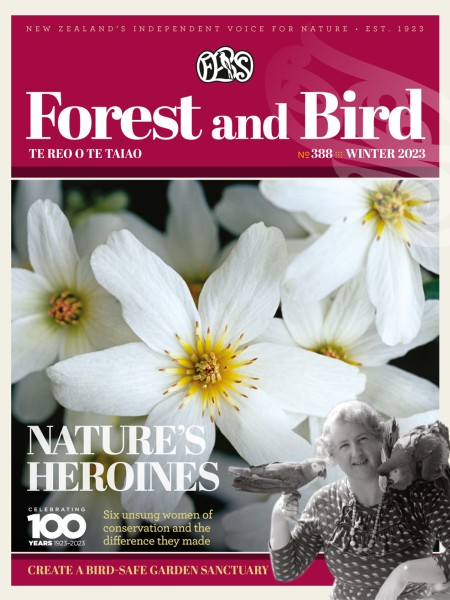Returning titipounamu to Bushy Park Tarapuruhi was a labour of love, with many working together to provide a safe new home for this tiny taonga.
Forest & Bird magazine
A version of this story was first published in the Winter 2023 issue of Forest & Bird magazine.

In late April, Forest & Bird’s Bushy Park Tarapuruhi, near Whanganui, welcomed its newest residents, an ancient species of wren only found only in Aotearoa New Zealand.
Mana whenua refer to titipounamu rifleman as “messengers to the gods” – specifically Tāne, God of the Forest. The tiny birds have a high-pitched buzzing call at a frequency many people cannot hear.
A total of 60 titipounamu were returned to Bushy Park, in a hapū-to-hāpu translocation to a sanctuary made safe by Bushy Park Tarapuruhi conservation volunteers.
The green-mantled birds – about the size of a golf ball – immediately set about exploring their new home and could be seen flitting about the restored forest canopy.
“Providing a home for these wee birds has required a careful and concerted effort by many partners and experts,” said Forest & Bird’s chief executive Nicola Toki, who attended the translocation.
“We’re extremely grateful for the support we’ve received to make this hapū-to-hapū project a reality, as we welcome these special ambassadors from Taranaki to their new home.”
The fenced predator-free sanctuary is a partnership between Forest & Bird, the Bushy Park Trust, and members of local iwi Ngaa Rauru Kiitahi, including Tamahereroto, Ngāti Pukeko, and Ngāti Maika hapū.
The translocation took place thanks to the generosity of Taranaki Maunga hapū (Puketapu, Pukerangiora, and Ngāti Tawhirikura, all of Te Atiawa iwi), who gifted the birds to Bushy Park and gave each one a name.
It’s the second time titipounamu have been moved from Taranaki Maunga in recent years to help establish a population elsewhere, said kuia Kura Niwa, of Pukerangiora hapū.
“A decade ago, we would never have thought we’d be leading a process of taurima adoption for manu, so we are thrilled our titipounamu population is doing so well that we are able to undertake this tikanga,” she said.
“We look forward to connecting more with our whānau Ngaa Rauru Kiitahi and seeing how the manu go in their new kāinga home.”
A 12-person capture team moved the birds in small groups over several days from a source site at Project Mounga, on Mount Taranaki, and released into their new home at Bushy Park Tarapuruhi.
“Kaupapa such as manu translocations gives us a common purpose to work together and achieve,” said Danny Broughton, of Ngaa Rauru Kiitahi.
“A kaupapa that requires respect of culture, processes, and above all the best for the manu and ultimately our ngāhere.”
Nicola Toki, CE Forest & Bird (left) with Mandy Brooke, Sanctuary Manager, Bushy Park Tarapuruhi (right) at the titipounamu translocation. Image Credit Alina Huff
The project was led by translocation specialist Kevin Parker, of Parker Conservation.
“Catching is always weather dependent as we cannot work in rain or high wind, and this week has been no exception,” he said. “Our top priority, as always, is to minimise stress on these birds.”
Bushy Park Tarapuruhi has previously seen translocations of toutouwai North Island robin, tīeke saddleback, and hihi stitchbird, and last year pōpokotea whitehead arrived in the sanctuary.
“Bringing these birds back to their ancestral home at Bushy Park Tarapuruhi helps us to restore the missing pieces of the ecosystem in an important site,” adds Nicola.
“It’s a credit to the project’s many volunteers, who contribute between 500 and 600 hours a month – as well as input and advice from all involved in this translocation.
“Everyone here is determined to provide a safe predator-free environment for titipounamu and other threatened species to thrive and repopulate the ngāhere.”
Titipounamu are our smallest endemic birds. Once common throughout Aotearoa, their populations have tanked over the past century due to predation and forest loss.
They are relatively poor flyers, which means that once extinct in a certain area, such as Bushy Park Tarapuruhi, new birds can’t fly in to re-establish a population.
Forest & Bird’s Bushy Park Sanctuary Manager Mandy Brooke hopes the new residents will feel comfortable in their new forest home and start breeding.
“The toutouwai and tīeke translocations have been so successful, we have been able to gift some of our birds to start populations in other places. It would be wonderful if this new titipounamu population is equally successful.”
The Bushy Park Tarapuruhi titipounamu translocation is part of Forest & Bird’s year of centennial celebrations. We would like to acknowledge Horizons Regional Council, the Tindall Foundation, and WWF-New Zealand helping fund this translocation.
What's in a name?
Titipounamu is a combination of tītiti, which means “a mirage of” and pounamu greenstone. The te reo name refers to the bird’s green colouring and the way it flits about in the treetops. The English name rifleman references the green military jackets New Zealand riflemen wore in the 19th century.

Titipounamu rifleman. Image Glenda Rees

